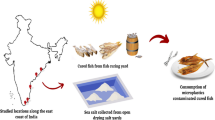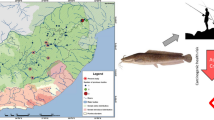Abstract
Signal crayfish (Pacifastacus leniusculus) is an invasive species displacing native European crayfish from their natural habitats. The elemental composition of the population from the southern Baltic coastal river and the potential health hazards are not known. The aim of the conducted research was to assess the quantitative content of Al, As, Ca, Cd, Cu, Fe, K, Mg, Na, Ni, Pb, Se, and Zn in meat, hepatopancreas, and exoskeleton in a population from Wieprza River (Poland) and compare the results with the recommendations of daily human consumption. Analysis also involved the composition of water and sediments. The concentrations of elements were analyzed using an Atomic Absorption Spectrometer. The bioconcentration factor (BCF) of elements in the signal crayfish was much higher from water than from sediments. Bioaccumulation of elements differed between the particular parts of the body of crayfish, e.g., Ca showed extreme predominance in the exoskeleton, while in meat exhibited a predominance of K, Na, Ca, and Mg. Among trace elements, crayfish meat was the richest in Zn, Cu, and Fe. The concentrations of non-essential Cd, Pb, and As were low compared to other determined elements. The highest concentrations of As, Cd, Cu, Fe, Ni, and Se were found in the hepatopancreas, while the highest levels of Al and Pb were found in the exoskeleton. Generally, it was found that the meat of P. leniusculus can be a perfect supplement to the human diet, and the consumption of 100 g of meat per day did not exceed the dietary reference values for essential elements and also for Al, As, Cd, Ni, and Pb.

Similar content being viewed by others
References
Barrento S, Marques A, Teixeira B, Analceto P, Carvalho ML, Vaz-Pires P, Nunes ML (2009) Macro and trace elements in two populations of brown crab Cancer pagurus: ecological and human health implications. J Food Compos Anal 22:65–71. https://doi.org/10.1016/j.jfca.2008.07.010
Barrento S, Marques A, Teixeira B, Carvalho ML, Vaz-Pires P, Nunes ML (2009) Influence of season and sex on the contents of minerals and trace elements in brown crab (Cancer pagurus, Linnaeus, 1758). J Agric Food Chem 57:3253–3260. https://doi.org/10.1016/j.jfca.2015.03.002
Rainbow PS (2007) Trace metal bioaccumulation: models, metabolic availability and toxicity. Environ Int 33:576–582. https://doi.org/10.1016/j.envint.2006.05.007
Islam B, Mia B, Razzaque A, Sarker M, Rahman R, Jalil A, Rahim A, Roy DK (2016) Investigation on mineral composition of freshwater crab (Paratelphusa lamellifrons) of Padma River near Rajshahi City, Bangladesh. Int J Fish Aquatic Studies 4(6):236–240
Skorupski J, Szenejsko M, Śmietana P, Panicz R, Keszka S, Czerniejewski P, Soroka M, Orłowska L, Albrycht M, Zatoń-Dobrowolska M, Moska M, Kirczuk L, Rymaszewska A (2017) Invasive alien species - identification of threats to protect biodiversity. Wyd. Green Federation “GAJA”, Polish Society of Conservation Genetics LUTREOLA.
Schulz R, Śmietana P (2001) Occurrence of native and introduced crayfish in Northeastern Germany and Northwestern Poland. B Fr Peche Pisci 361:629–641. https://doi.org/10.1051/kmae:2001009
Dobrzycka-Krahel A, Skóra ME, Raczyński M, Szaniawska A (2017) The signal crayfish Pacifastacus leniusculus - distribution and invasion in the Southern Baltic Coastal River. Pol J Ecol 65(3):445–452
Filipová L, Petrusek A, Matasová K, Delaunay C, Grandjean F (2013) Prevalence of the crayfish plague pathogen Aphanomyces astaci in populations of the signal crayfish Pacifastacus leniusculus in France: evaluating the threat to native crayfish. PLoS One 8(7):e70157. https://doi.org/10.1371/journal.pone.0070157
Momot WT, Gowing H, Jones PD (1978) The dynamics of crayfish and their role in aquatic ecosystems. Am Midl Nat 99(1):10–35
Harlioğlu MM, Holdich DM (2001) Meat yields in the introduced freshwater crayfish, Pacifastacus leniusculus (Dana) and Astacus leptodactylus Eschscholtz, from British waters. Aquac Res 32:411–417. https://doi.org/10.1046/j.1365-2109.2001.00577.x
Regulation EU, 1143/2014 of the European Parliament and of the Council of 22 October 2014 on the prevention and management of the introduction and spread of invasive alien species
Kouba A, Buřič M, Kozák P (2010) Bioaccumulation and effects of heavy metals in crayfish: a review. Water Air Soil Pollut 211:5–16. https://doi.org/10.1007/s11270-009-0273-8
Rainbow PS, Luoma SN (2010) Trace metals in aquatic invertebrates. In: Beyer WN, Meador JP (eds) Environmental contaminants in biota: interpreting tissue concentrations. Taylor and Francis Books, Boca Raton, pp 231–252
Reichmuth JM, Weis P, Weis JS (2010) Bioaccumulation and depuration of metals in blue crabs (Callinectes sapidus Rathbun) from a contaminated and clean estuary. Environ Pollut 158:361–368
Nieboer E, Richardson DHS (1980) The replacement of the nondescript “heavy metals” by a biologically and chemically significant classification of metal ions. Environ Pollut 1B:3–26
Rainbow PS (2002) Trace metal concentrations in aquatic invertebrates: why and so what? Environ Pollut 120:497–507
Goretti E, Pallottini M, Ricciarini MI, Selvaggi R, Cappelletti D (2016) Heavy metals bioaccumulation in selected tissues of red swamp crayfish: an easy tool for monitoring environmental contamination levels. Sci Total Environ 559:339–346. https://doi.org/10.1016/j.scitotenv.2016.03.169
Francesconi KA (2010) Arsenic species in seafood: origin and human health implications. Pure Appl Chem 82(2):373–381
Maguire I, Klobučar G (2011) Size structure, maturity size, growth and condition index of stone crayfish (Austropotamobius torrentium) in North-West Croatia. Knowl Manag Aquat Ecosyst 401:12. https://doi.org/10.1051/kmae/2011026
Jitar O, Teodosiu C, Oros A, Plavan G, Nicoara M (2015) Bioaccumulation of heavy metals in marine organisms from the Romanian sector of the Black Sea. New Biotechol 32:369–378
Vrhovnik P, Arrebola JP, Serafimovski T, Dolenec T, Smuc NR, Dolenec M, Mutch E (2013) Potentially toxic contamination of sediments, water and two animal species un Lake Kalimanci, FYR Macedonia: relevance to human health. Environ Pollut 180:92–100
Ross C, Taylor CL, Yaktine AL, del Valle HB (2011) Dietary reference intakes for calcium and vitamin D. National Academies Press, Washington. https://doi.org/10.17226/13050
Salahinejad M, Aflaki F (2010) Toxic and essential elements content of black tea leaves and their tea infusion consumed in Iran. Biol Trace Elem Res 134:109–117. https://doi.org/10.1007/s121011-00908449-z
StatSoft Inc. (2016) Statistica (data analysis software system), version 12.1. www.statsoft.com
Senze M, Kowalska-Góralska M, Pokorny P, Dobicki W, Polechoński R (2015) Accumulation of heavy metals in bottom sediments in Baltic Sea catchment rivers affected by the operations of petroleum and natural gas mines in Western Pomerania, Poland. Pol J Environ Stud 24(5):2167–2175
The state of the environment in the West Pomeranian Voivodeship. Report 2018. Voivodeship inspectorate of environmental protection, Szczecin, pp. 192. (in Polish)
Pokorny P, Senze M, Dobicki W, Kowalsak-Góra M, Polechoński R (2013) Geochemical assessment of Western Pomerania watercourse. Przem Chem 92(9):1768–1771
Hudina S, Zganec K, Hock K (2015) Differences in aggressive behaviour along the expanding range of an invasive crayfish: an important component of invasion dynamics. Biol Invasions 17:3101–3112
Souty-Grosset C, Holdich DM, Noel P (2006) Atlas of crayfish of Europe. Museum National d’Histoire Naturalle, Paris
Śmietana P, Krzywosz T (2006) Determination of the rate of growth of Pacifastacus leniusculus in Lake Pobłędzie using polymodal length frequency distribution analysis. B Fr Peche Pisci 380–381:1229–1244
Rebrina F, Skejo J, Lucić A, Hudina S (2015) Trait variability of the signal crayfish (Pacifastacus leniusculus) in a recently invaded region reflects potential benefits and trade-offs during dispersal. Aquat Invasions 10(1):41–50
Capurro M, Galli L, Mori M, Salvidio S, Arillo A (2015) Reproductive cycle of Pacifastacus leniusculus (Dana) (Crustacea: Decapoda) from the Brugneto Lake (Liguria, northwest Italy). Ital J Zool 82(3):366–377. https://doi.org/10.1080/11250003.2015.1022235
Protasowicki M, Własow T, Rajkowska M, Polna M, Bernard A (2013) Metal concentrations in selected organs of crayfish – Orconectes limosus and Pacifastacus leniusculus from Mazurian Lakes. J Elem 18(4):683–694. https://doi.org/10.5601/jelem.2013.18.4.537
Tunca E, Ucuncu E, Ozkan AD, Ulger ZE, Cansizoglu AE, Tekinay T (2013) Differences in accumulation and distribution profile of heavy metals and metalloid between male and female crayfish (Astacus leptodactylus). B Environ Contam Tox 90:70–577. https://doi.org/10.1007/s00128-013-0960-4
Adeyeye EI, Olanlokun JO, Falodun TO (2010) Proximate and mineral composition of whole body, flesh and exoskeleton of male and female common West African fresh water crab Sudananautes africanus africanus. Pol J Food Nut Sci 60(3):213–216
Jimmy UP, Arazu VN (2012) The Proximate and mineral composition of two edible crabs Callinectes amnicola and Uca tangeri (Crustecea: Decapoda) of the Cross river, Nigeria. Pak J Nutr 11(1):78–82
Nędzarek A, Czerniejewski P, Drost A, Harasimiuk F, Machula S, Tórz A, Masalski P (2017) The distribution of elements in the body of invasive Chinese mitten crabs (Eriocheir sinensis H. Milne-Edwards, 1853) from Lake Dąbie, Poland. J Food Compos Anal 60:1–9
Nędzarek A, Czerniejewski P, Tórz A (2019) Macro- and trace elements in Chinese mitten crabs (Eriocheir sinensis) from Szczecin Lagoon, Poland – implications for human health. Aquaculture 506:229–237. https://doi.org/10.1016/j.aquaculture.2019.03.042
Pires C, Marques A, Carvalho ML, Batista I (2017) Chemical characterization of Cancer pagurus, Maja Squinado, Necora puber and Carcinus maenas shells. Poul Fish Wildl Sci 5(1):1–6. https://doi.org/10.4172/2375-446X.1000181
Boßelmann F, Romano P, Fabritius H, Raabe D, Epple M (2007) The composition of the exoskeleton of two crustacean: the American lobster Homarus americanus and the edible crab Cancer pagurus. Thermochim Acta 463:65–68
Hothem RL, Bergen DR, Bauer ML, Crayon JJ, Meckstroth AM (2007) Mercury and trace elements in crayfish from Northern California. B Environ Contam Tox 79:628–632. https://doi.org/10.1007/s00128-007-9304-6
Rana MS, Halim MA, Safiullah S, Mamun Mollan M, Azam MS, Goni MA, Kamal Hossain M, Rana MM (2009) Removal of heavy metal from contaminated water by biopolymer crab shell chitosan. J Appl Sci 9(15):2762–2769
Bergey LL, Weis JS (2007) Molting as a mechanism of depuration of metals in the fiddler crab, Uca pugnax. Mar Environ Res 64:556–562
Tao Y, Yuan Z, Xiaona H, Wein M (2012) Distribution and bioaccumulation of heavy metals in aquatic organisms of different trophic levels and potential health risk assessment from Taihu lake, China. Ecotox Environ Safe 81:55–64
Costanza J, Lynch DG, Boethling RS, Arnot JA (2012) Use of the bioaccumulation factor to screen chemicals for bioaccumulation potential. Environ Toxicol Chem 31(10):2261–2268
Varol M, Sünbül MR (2018) Biomonitoring of trace metals in the Keban Dam Reservoir (Turkey) using mussels (Unio elongatulus eucirrus) and crayfish (Astacus leptodactylus). Biol Trace Elem Res 185(1):216–224
Canpolat O, Eroglu M, Dusukcan M (2016) Transfer factor of some heavy metals in muscle of Cyprinus carpio. Fresenius Environ Bull 25(11):4988–4994
Commission Regulation (EU) No 420/2011 of 29 April 2011 amending Regulation (EC) No 1881/2006 setting maximum levels for certain contaminants in foodstuffs. https://www.fsai.ie/uploadedFiles/Reg420_2011.pdf. Accessed 9 March 2018
Food and Agriculture Organization (FAO) Heavy metal regulations – Faolex. Legal Notice no. 66/2003. http://faolex.fao.org/docs/pdf/eri42405.pdf. Accessed 6 March 2018
Author information
Authors and Affiliations
Corresponding author
Ethics declarations
Conflict of Interest
The author declares that they have no conflict of interest.
Additional information
Publisher’s Note
Springer Nature remains neutral with regard to jurisdictional claims in published maps and institutional affiliations.
Electronic supplementary material
ESM 1
(PDF 878 kb)
Rights and permissions
About this article
Cite this article
Nędzarek, A., Czerniejewski, P. & Tórz, A. Macroelements and Trace Elements in Invasive Signal Crayfish (Pacifastacus leniusculus) from the Wieprza River (Southern Baltic): Human Health Implications. Biol Trace Elem Res 197, 304–315 (2020). https://doi.org/10.1007/s12011-019-01978-y
Received:
Accepted:
Published:
Issue Date:
DOI: https://doi.org/10.1007/s12011-019-01978-y




